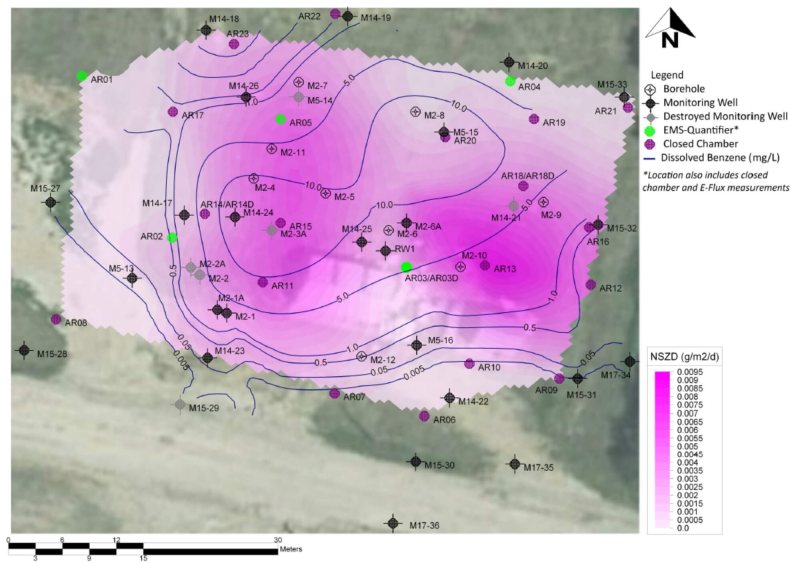Natural Source Zone Depletion Case Study
September 7, 2023
As part of the decommissioning process, an initial Phase II Environmental Site Assessment was conducted on a former Bulk Fuel Facility that operated from the early 1960s to 2002.

The Problem
As part of the decommissioning process, an initial Phase II Environmental Site Assessment was conducted on a former Bulk Fuel Facility that operated from the early 1960s to 2002. The assessment identified the following:
- Petroleum hydrocarbon contamination in soil ranging from 10 to 17 metres below ground surface (mbgs).
- Depth to groundwater has an average depth of 18 m bgs.
During subsequent monitoring events, Light non-aqueous phase liquid (LNAPL) was detected in multiple wells. To deal with the LNAPL, a Spill Buster which is an automated recovery system, was added to the first recovery well (RW-1) in 2011, with a second Spill Buster added to another well (M5-14) in 2016. However, due to the fine-grained lithology, minimal amounts of LNAPL were recovered. Additionally, the depth of contamination made it difficult to implement a traditional remediation technology.
The Implemented Solution
A drive-point network, consisting of 36 injection wells, was installed in 2015 (Figure 1). The BioLodestone, a proprietary amendment solution, was delivered to the contaminated area for 1 month in 2015 and 3-4 months for 2016, 2017, 2018, 2019, 2020.
The Results
In late 2020, five solar-powered Soil Sense units were installed at the site including 1 background location, 2 on the plume fringe and 2 within the plume. The strategy for placement of the Soil Sense was to capture areas of high and low benzene concentrations. Soil Sense units make use of concentration gradient methodology with the sensor packs being installed above the LNAPL plume at depths of 3, 5 and 6 m bgs. The Soil Sense, a proprietary technology, uses three solid state sensor packs installed at different depths to measure:
- Hydrocarbon vapours;
- Oxygen;
- Carbon dioxide; and
- Methane.
The data is collected from the Soil Sense at 30-minute intervals 365 days a year and can be incorporated into site-wide estimates of Natural Source Zone Depletion and Plume Stability. This allows site managers remote insight into remedial progress without having to step foot on-site.
Site-wide Estimates
Initial estimates indicated an average site-wide NSZD rate of 0.13 grams per square metre per day (g/m2/d) (Figure 1) with an approximate mass reduction of 15 kilograms per year (kg/yr). The highest NSZD rates were situated within the plume source (location 3).
Comparison to Traditional NSZD Methods
A comparison to traditional NSZD methods (Closed Chamber and E-Flux traps) suggested the Soil Sense units were within the NSZD range (Figure 2). The closed chamber results, while showing lower rates, tend to correlate with the plume areas and our Soil Sense units. Further, the E-Flux results at location 5 correlate to a high degree with the high end of the range for our Soil Sense units. The flux trap at location 3 had a non-detect. This result is anomalous and could have resulted for several reasons but highlights the importance of real time data so that in the event a Soil Sense unit fails it’s identified right away and can be fixed immediately.

Figure 1. Natural Source Zone Depletion Rates highlighting the variation over a 5-month period.

Figure 2. A Comparison of Traditional Natural Source Zone Depletion Rates including Soil Sense (green, formerly LiORA-Quantifier), Closed Chamber (purple). E-Flux CO2 traps were installed at the same locations as the Soil Sense.
Team Leads

Steven Siciliano
As CEO of LiORA, Dr. Steven Siciliano brings his experience as one of the world’s foremost soil scientists to the task of helping clients to efficiently achieve their remediation goals. Dr. Siciliano has made significant contributions to the progress of environmental and soil science with 11 book chapters and 220 scientific papers which have been cited over 17,000 times.
Discover More
The latest industry news, interviews, technologies, and resources.
.webp)
Natural Source Zone Depletion Validation: How Much Hydrocarbon is Naturally Degrading
12 June 2024
Natural Source Zone Depletion (NSZD) refers to microbial and physical processes that reduce hydrocarbon content in the subsurface. Microorganisms degrade hydrocarbons deep in the soil and rapidly deplete available oxygen and other electron acceptors in the soil and groundwater. At that point, microorganisms begin to ferment hydrocarbons, producing organic acids. These organic acids are used by a group of microorganisms called methanogens, which consume these organic acids and release methane. The methane migrates towards the upper layers of soil, where another group of organisms, called methanotrophs, consume the methane and release carbon dioxide as a product.

ESG & Savings from Upstream Spill Bioremediation
27 May 2024
An active petroleum hydrocarbon pipeline site had 20,000 m3 of impact and an initial plume area of 8,100 m2 based on an environmental consulting firm’s Phase II Environmental Assessment. An active recovery program over five (5) years had recovered approximately 14% of the released product but was discontinued due to declining extraction efficiencies with high operating costs.
